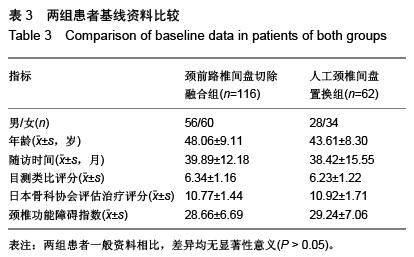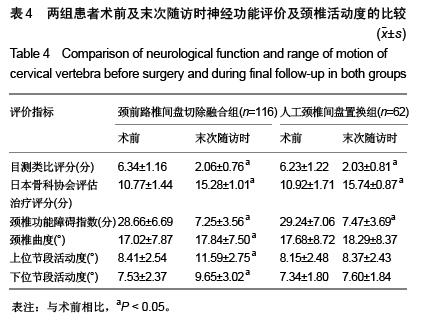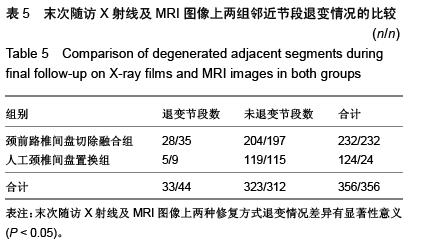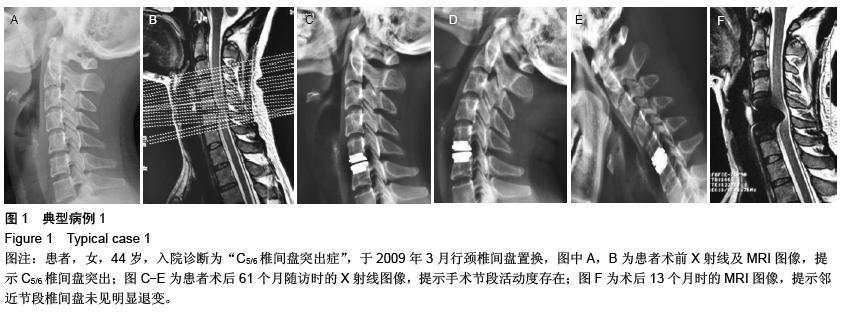| [1] 陈孝平,石应康,邱贵兴等.外科学[M],北京:人民卫生出版社, 2010:1040.
[2] Goffin J,Geusens E,Vantomme N, et al. Long-term follow-up after interbody fusion of the cervical spine. J Spinal Disord. 2004;17(2):79-85.
[3] Engquist M, Löfgren H, Öberg B, et al. Surgery versus nonsurgical treatment of cervical radiculopathy: a prospective, randomized study comparing surgery plus physiotherapy with physiotherapy alone with a 2-year follow-up. Spine. 2013; 38(20):1715-1722.
[4] Suk KS, Lee SH, Park SY, et al. Clinical 0utcome and changes of foraminal dimension in patients with foraminal stenosis after ACDF. J Spinal Disord Tech. 2015;28(8): E499-E453.
[5] Rick B, Jack D. Five-year reoperation rates,cervical total disc replacement versus fusion,results of a prospective randomized clinical trial. Spine. 2013;38(9):711-717.
[6] Vaccaro A, Beutler W, Peppelman W, et al. Clinical outcomes with selectively constrained SECURE-C cervical disc arthroplasty: two-year results from a prospective, randomized, controlled, multicenter investigational device exemption study. Spine. 2013;38(26):2227-2239.
[7] Heller JG, Sasso RC, Papadopoulos SM, et al. Comparison of BRYAN cervical disc arthroplasty with anterior cervical decompression and fusion: clinical and radiograph is results of a randomized, controlled, clinical trial. Spine. 2009;34(2): 101-107.
[8] McAfee PC, Reah C, Gilder K, et al. A meta- analysis of comparative outcomes following cervical arthroplasty or anterior cervical fusion: results from 4 prospective multicenter randomized clinical trials and up to 1226 patients. Spine. 2012; 37(11):943-952.
[9] Garrido BJ, Taha TA, Sasso RC. Clinical outcomes of bryan cervical disc arthroplasty a prospective, randomized, controlled,single site trial with 48-month follow-up. J Spinal Disord Tech. 2010;23(6):367-371.
[10] 任先军,王卫东,初同伟,等.人工颈椎间盘置换后的早中期临床疗效[J].中国矫形外科杂志,2009,17(3):164-167.
[11] 张建宁,刘博,张川.重视脊髓损伤的神经功能评价[J].中国现代神经疾病杂志,2009,9(2):109-112.
[12] Sterling M, Rebbeck T. The Neck Disability Index (NDI). Aust J Physiother. 2005;51(4):271.
[13] Sundseth J, Kolstad F, Johnsen G, et al. The Neck Disability Index (NDI) and its correlation with quality of life and mental health measures among patients with single-level cervical disc disease scheduled for surgery. Acta Neurochirurgica. 2015;157(10):1807-1812.
[14] Fukui M, Chiba K, Kawakami M, et al. JOA Back Pain Evaluation Questionnaire (JOABPEQ)/JOA Cervical Myelopathy Evaluation Questionnaire (JOACMEQ). The report on the development of revised versions. April 16, 2007. The Subcommittee of the Clinical Outcome Committee of the Japanese Orthopaedic Association on Low Back Pain and Cervical Myelopathy Evaluation. J Orthop Sci. 2009;14(3): 348-365.
[15] 刘雅普,夏虹,艾福志,等.人工颈椎间盘置换后邻近节段退变情况的早中期随访[J].中国修复重建外科杂志,2012,26(4):385-389.
[16] 张雪松,张永刚,肖嵩华,等.单节段人工椎间盘置换治疗颈椎病的中长期疗效[J].中国脊柱脊髓杂,2012,22(10):879-883.
[17] Pingel A, Kandziora F. Anterior decompression and fusion for cervical spinal canal stenosis. Eur Spine J. 2013;22(3): 673-674.
[18] Robert C. Surgical Treatment and Outcomes of Cervical Radiculopathy. Phys Med Rehabil Clin N Am. 2011;22(1): 179-191.
[19] Shiban E, Gapon K, Wostrack M, et al. Clinical and radiological outcome after anterior cervical discectomy and fusion with stand-alone empty polyetheretherketone (PEEK) cages. Acta Neurochir. 2015;12(1):1-7.
[20] van Eck CF, Regan C, Donaldson WF, et al. The revision rate and occurrence of adjacent segment disease after anterior cervical discectomy and fusion: a study of 672 consecutive patients. Spine. 2014;39(26):2143-2147.
[21] Li J, Li YQ, Kong FL, et al. Adjacent segment degeneration after single-level anterior cervical decompression and fusion: disc space distraction and its impact on clinical outcomes. J Clin Neurosci. 2015;22(3):566-569.
[22] Matsumoto M, Okada E, Ichihara D, et al. Anterior cervical decompression and fusion accelerates adjacent segment degeneration: comparison with asymptomatic volunteers in a ten-year magnetic resonance imaging follow-up study. Spine. 2010;35(1):36-43.
[23] Miao JH, Yu FB, Shen Y, et al. Clinical and radiographic outcomes of cervical disc replacement with a new prosthesis. Spine J. 2014;14(6):878-883.
[24] Munigangaiah S, McCabe JP. Anterior cervical disc replacement for degenerative disc disease. J Orthop Surg. 2014;22(3):364-367.
[25] Skovrlj B, Lee DH, Caridi JM, et al. Reoperations Following Cervical Disc Replacement. Asian Spine J. 2015;9(3): 471-482.
[26] Coric D, Kim PK, Clemente JD, et al. Prospective randomized study of cervical arthroplasty and anterior cervical discectomy and fusion with long-term follow-up: results in 74 patients from a single site. J Neurosurg Spine. 2013;18(1):36-42.
[27] Shedid D, Edward C. Cervical spondylosis anatomy: pathophysiology and biomechanics. Neurosurgery. 2007; 60(1):S7-S13.
[28] Rick C, Natalie M, Best Newton H, et al. Motion analysis of bryan cervical disc arthroplasty versus anterior discectomy and fusion: results from a prospective, randomized, multicenter, clinical trial. J Spinal Disorder Tech. 2008;21(6): 393-399.
[29] Zhang HX, Shao YD, Chen Y, et al. A prospective, randomised, controlled multicentre study comparing cervical disc replacement with anterior cervical decompression and fusion. Int Orthop. 2014;38(12):2533-2541.
[30] 王义生,邓俊森.颈椎前路融合后相邻节段退变的临床观察与分析[J].中国矫形外科杂志,2012,20(9):786-788.
|
.jpg)



.jpg)

.jpg)
.jpg)
.jpg)